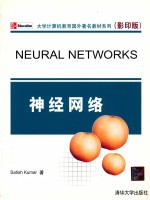图书介绍
神经网络PDF|Epub|txt|kindle电子书版本网盘下载

- (印)库马尔(Kumar,S.)著 著
- 出版社: 北京:清华大学出版社
- ISBN:7302135525
- 出版时间:2006
- 标注页数:741页
- 文件大小:329MB
- 文件页数:764页
- 主题词:人工神经元网络-高等学校-教材-英文
PDF下载
下载说明
神经网络PDF格式电子书版下载
下载的文件为RAR压缩包。需要使用解压软件进行解压得到PDF格式图书。建议使用BT下载工具Free Download Manager进行下载,简称FDM(免费,没有广告,支持多平台)。本站资源全部打包为BT种子。所以需要使用专业的BT下载软件进行下载。如BitComet qBittorrent uTorrent等BT下载工具。迅雷目前由于本站不是热门资源。不推荐使用!后期资源热门了。安装了迅雷也可以迅雷进行下载!
(文件页数 要大于 标注页数,上中下等多册电子书除外)
注意:本站所有压缩包均有解压码: 点击下载压缩包解压工具
图书目录
Part Ⅰ Traces of History and A Neuroscience Briefer3
1.Brain Style Computing:Origins and Issues3
1.1 From the Greeks to the Renaissance3
1.2 The Advent of Modern Neuroscience6
1.3 On the Road to Artificial Intelligence9
1.4 Classical AI and Neural Networks12
1.5 Hybrid Intelligent Systems14
Chapter Summary15
Bibliographic Remarks16
2.Lessons from Neuroscience17
2.1 The Human Brain17
2.2 Biological Neurons23
Chapter Summary37
Bibliographic Remarks38
Part Ⅱ Feedforward Neural Networks and Supervised Learning38
3.Artificial Neurons,Neural Networks and Architectures41
3.1 Neuron Abstraction41
3.2 Neuron Signal Functions44
3.3 Mathematical Preliminaries53
3.4 Neural Networks Defined61
3.5 Architectures:Feedforward and Feedback62
3.6 Salient Properties and Application Domains of Neural Networks65
Chapter Summary68
Bibliographic Remarks69
Review Questions69
4.Geometry of Binary Threshold Neurons and Their Networks72
4.1 Pattern Recognition and Data Classification72
4.2 Convex Sets.Convex Hulls and Linear Separability76
4.3 Space of Boolean Functions78
4.4 Binary Neurons are Pattern Dichotomizers80
4.5 Non-linearly Separable Problems83
4.6 Capacity of a Simple Threshold Logic Neuron87
4.7 Revisiting thie XOR Problem92
4.8 Multilayer Networks95
4.9 How Many Hidden Nodes are Enough?97
Chapter Summary99
Bibliographic Remarks100
Review Questions100
5.Supervised Learning Ⅰ:Perceptrons and LMS104
5.1 Learning and Memory104
5.2 From Synapses to Behaviour:The Case of Aplysia106
5.3 Learning Algorithms110
5.4 Error Correction and Gradient Descent Rules114
5.5 The Learning Objective for TLNs115
5.6 Pattern Space and Weight Space117
5.7 Perceptron Learning Algorithm119
5.8 Perceptron Convergence Theorem122
5.9 A Handworked Example and MATLAB Simulation125
5.10 Perceptron Learning and Non-separable Sets128
5.11 Handling Linearly Non-separable Sets130
5.12 α-Least Mear Square Learning132
5.13 MSE Error Surface and its Geometry137
5.14 Steepest Descent Search with Exact Gradient Information143
5.15 μ-LMS:Approximate Gradient Descent147
5.16 Application of LMS to Noise Cancellation152
Chapter Summary156
Bibliographic Remarks157
Review Questions158
6.Supervised Learning Ⅱ:Backpropagation and Beyond164
6.1 Multilayered Network Architectures164
6.2 Backpropagation Learning Algorithm167
6.3 Handworked Example177
6.4 MATLAB Simulation Examples181
6.5 Practical Considerations in Implementing the BP Algorithm187
6.6 Structure Growing Algorithms196
6.7 Fast Relatives of Backpropagation198
6.8 Universal Function Approximation and Neural Networks199
6.9 Applications of Feedforward Neural Networks201
6.10 Reinforcement Learning:A Brief Review205
Chapter Summary212
Bibliographic Remarks213
Review Questions214
7.Neural Networks:A Statistical Pattern Recognition Perspective218
7.1 Introduction218
7.2 Bayes'Theorem219
7.3 Two Instructive MATLAB Simulations222
7.4 Implementing Classification Decisions with Bayes'Theorem227
7.5 Probabilistic Interpretation of a Neuron Discriminant Function230
7.6 MATLAB Simulation:Plotting Bayesian Decision Boundaries232
7.7 Interpreting Neuron Signals as Probabilities236
7.8 Multilayered Networks,Error Functions and Posterior Probabilities239
7.9 Error Functions for Classification Problems245
Chapter Summary254
Bibliographic Remarks255
Review Questions255
8.Focussing on Generalization:Support Vector Machines and Radial Basis Function Networks259
8.1 Learning From Examples and Generalization259
8.2 Statistical Learning Theory Briefer264
8.3 Support Vector Machines273
8.4 Radial Basis Function Networks304
8.5 Regularization Theory Route to RBFNs314
8.6 Generalized Radial Basis Function Network323
8.7 Learning in RBFN's326
8.8 Image Classification Application329
8.9 Other Models For Valid Generalization334
Chapter Summary339
Bibliographic Remarks341
Review Questions341
Part Ⅲ Recurrent Neurodynamical Systems347
9.Dynamical Systems Review347
9.1 States,State Vectors and Dynamics347
9.2 State Equations350
9.3 Attractors and Stability352
9.4 Linear Dynamical Systems354
9.5 Non-linear Dynamical Systems358
9.6 Lyapunov Stability363
9.7 Neurodynamical Systems369
9.8 The Cohen-Grossberg Theorem373
Chapter Summary375
Bibliographic Remarks376
Review Questions376
10.Attractor Neural Networks378
10.1 Introduction378
10.2 Associative Learning379
10.3 Attractor Neural Network Associative Memory382
10.4 Linear Associative Memory386
10.5 Hopfield Network389
10.6 Content Addressable Memory397
10.7 Two Handworked Examples400
10.8 Example of Recall of Memories in Continuous Time404
10.9 Spurious Attractors405
10.10 Error Correction with Bipolar Encoding407
10.11 Error Performance of Hopfield Networks409
10.12 Applications of Hopfield Networks412
10.13 Brain-State-in-a-Box Neural Network419
10.14 Simulated Annealing426
10.15 Boltzmann Machine431
10.16 Bidirectional Associative Memory440
10.17 Handworked Example443
10.18 BAM Stability Analysis447
10.19 Error Correction in BAMs448
10.20 Memory Annihilation of Structured Maps in BAMs450
10.21 Continuous BAMs457
10.22 Adaptive BAMs458
10.23 Application:Pattern Association461
Chapter Summary462
Bibliographic Remarks464
Review Questions464
11.Adaptive Resonance Theory469
11.1 Noise-Saturation Dilemma469
11.2 Solving the Noise-Saturation Dilemma471
11.3 Recurrent On-center-Off-surround Networks477
11.4 Building Blocks of Adaptive Resonance482
11.5 Substrate of Resonance487
11.6 Structural Details of the Resonance Model489
11.7 Adaptive Resonance Theory Ⅰ(ART Ⅰ)491
11.8 Handworked Example502
11.9 MATLAB Code Description504
11.10 A Breezy Review of ART Operating Principles506
11.11 Neurophysiological Evidence for ART Mechanisms507
11.12 Applications511
Chapter Summary516
Bibliographic Remarks517
Review Questions518
12.Towards the Self-organizing Feature Map521
12.1 Self-organization521
12.2 Maximal Eigenvector Filtering522
12.3 Extracting Principal Components:Sanger's Rule530
12.4 Generalized Learning Laws532
12.5 Competitive Learning Revisited537
12.6 Vector Quantization540
12.7 Mexican Hat Networks546
12.8 Self-organizing Feature Maps552
12.9 Applications of the Self Organizing Map563
Chapter Summary569
Bibliographic Remarks570
Review Questions571
Part Ⅳ Contemporary Topics577
13.Pulsed Neuron Models:The New Generation577
13.1 Introduction577
13.2 Spiking Neuron Model578
13.3 Integrate-and-Fire Neurons586
13.4 Conductance Based Models594
13.5 Computing with Spiking Neurons608
13.6 Reflections...616
Chapter Summary617
Bibliographic Remarks618
14.Fuzzy Sets,Fuzzy Systems and Applications620
14.1 Need for Numeric and Linguistic Processing620
14.2 Fuzzy Uncertainty and the Linguistic Variable621
14.3 Fuzzy Set622
14.4 Membership Functions624
14.5 Geometry of Fuzzy Sets627
14.6 Simple Operations on Fuzzy Sets628
14.7 Fuzzy Rules for Approximate Reasoning632
14.8 Rule Composition and Deffuzification634
14.9 Fuzzy Engineering638
14.10 Applications644
Chapter Summary649
Bibliographic Remarks650
Review Questions650
15.Neural Networks and the Soft Computing Paradigm652
15.1 Soft Computing=Neural+Fuzzy+Evolutionary652
15.2 Neural Networks:A Summary654
15.3 Fuzzy Sets and Systems:A Summary656
15.4 Genetic Algorithms658
15.5 Neural Networks and Fuzzy Logic662
15.6 Neuro-Fuzzy-Genetic Integration671
15.7 Integration Example:Subsethood-Product Based Fuzzy-Neural Inference System675
15.8 A Concluding Note683
Chapter Summary684
Bibliographic Remarks685
Appendix A:Neural Network Hardware686
A.1 Motivation and Issues686
A.2 Analog Building Blocks for Neuromorphic Networks687
A.3 Digital Techniques691
A.4 Bibliographic Remarks692
Appendix B:Web Pointers694
Bibliography697
Index729